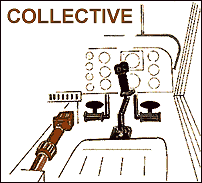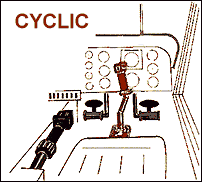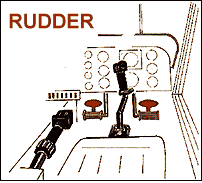The helicopter is steered in any direction by inclining the axis of the main rotor in
that direction. Flying a helicopter requires great concentration.

You must use one hand on the control lever that is at your side
(the collective control stick) to raise or lower the helicopter,
while at the same time controlling the throttle (not an easy task).
This is a control which is only found in helicopters and is linked to the engine power. Moving this up and down changes the pitch of the main rotors. As the pitch is increased more power is required from the engines so that the rotor speed is kept at the same level.

You must use your other hand on the control lever that is just in front of you
(the cyclic control stick) to move the helicopter forward,
backward and to either side, as if you were in a conventional aircraft.
Moving it forward or back will point the nose of the helicopter up or down. It does this by varying the angle of the rotor blades as they go round, tilting the rotor back and forth. When moved left or right the rotor tilts in that direction and the helicopter banks and rolls.

And finally you must use the tail rotor pedals ( RUDDER for a fixed wing aircraft ), on the floor, to control the pitch
of the tail-rotor. For straight flight, the pitch of the tail rotor is set to prevent
the helicopter from turning to the right as the main rotor turns to the left. The pilot
pushes the left pedal to increase the pitch of the tail rotor and turn to the left.
Pushing the right pedal decreases the pitch of the tail rotor and turns the helicopter
to the right.
On tandem rotors helicopters, like Boeing 's Chinook, that had no tail rotor, the pedals are connected to the swashplates and cyclically change pitch on both rotors in equal, but opposite directions. For example, if the left pedal is pressed at a hover, the front rotor disk tips left and the rear rotor tips right so that the helicopter yaws to the left.
To Climb, the angle or pitch of the blades is increased. To descend, the pitch of the blades is decreased. Because all blades are acting simultaneously, or collectively, this is known as collective pitch .
For forward, backward and sideways flight an additional change of pitch is provided. By this means the pitch of each blade increases at the same selected point in its circular pathway. This is the cyclic pitch .
With these two controls in mind let us make an imaginary flight. With the engine warmed up and the rotor blades whirling above us in flat pitch, that is, with no angle or bite in the air, we are ready to start.
We increase the collective pitch. The rotor blades bite into the air, each to the same degree, and lift the helicopter vertically.
Now we decide to fly forward. We still have collective pitch to hold us in the air and we adjust the cyclic pitch so that as each blade passes over the tail of the helicopter, it has more bite on the air than when it passes over the nose. Naturally the helicopter travels forward.
Now we decide to stop and hover motionless so we put the cyclic pitch in neutral, the rotor blades now have the same pitch throughout their cycle, and the collective pitch holds the helicopter suspended in space without moving in any direction.
In short, it is the cyclic and collective pitch which gives the helicopter its unique ability to fly forward, backwards, sideways, rise and descend vertically and hover motionless in the air , making it one of the most versatile vehicles known by man .

This is a control which is only found in helicopters and is linked to the engine power. Moving this up and down changes the pitch of the main rotors. As the pitch is increased more power is required from the engines so that the rotor speed is kept at the same level.

Moving it forward or back will point the nose of the helicopter up or down. It does this by varying the angle of the rotor blades as they go round, tilting the rotor back and forth. When moved left or right the rotor tilts in that direction and the helicopter banks and rolls.

On tandem rotors helicopters, like Boeing 's Chinook, that had no tail rotor, the pedals are connected to the swashplates and cyclically change pitch on both rotors in equal, but opposite directions. For example, if the left pedal is pressed at a hover, the front rotor disk tips left and the rear rotor tips right so that the helicopter yaws to the left.
Pilot Skills
Flying a helicopter requires entirely different skills than flying conventional aircraft. This is why it is difficult to fly a vertical take-off or landing (VTOL) aircraft since both skills are required when making the transition from vertical to horizontal flight.How the Helicopter Flies ...
Flight of a helicopter is governed by the pitch or angle of its rotor blades as they sweep through the air. For climbing and descending, the pitch of all the blades is changed at the same time and in the same degree.To Climb, the angle or pitch of the blades is increased. To descend, the pitch of the blades is decreased. Because all blades are acting simultaneously, or collectively, this is known as collective pitch .
For forward, backward and sideways flight an additional change of pitch is provided. By this means the pitch of each blade increases at the same selected point in its circular pathway. This is the cyclic pitch .
With these two controls in mind let us make an imaginary flight. With the engine warmed up and the rotor blades whirling above us in flat pitch, that is, with no angle or bite in the air, we are ready to start.
We increase the collective pitch. The rotor blades bite into the air, each to the same degree, and lift the helicopter vertically.
Now we decide to fly forward. We still have collective pitch to hold us in the air and we adjust the cyclic pitch so that as each blade passes over the tail of the helicopter, it has more bite on the air than when it passes over the nose. Naturally the helicopter travels forward.
Now we decide to stop and hover motionless so we put the cyclic pitch in neutral, the rotor blades now have the same pitch throughout their cycle, and the collective pitch holds the helicopter suspended in space without moving in any direction.
In short, it is the cyclic and collective pitch which gives the helicopter its unique ability to fly forward, backwards, sideways, rise and descend vertically and hover motionless in the air , making it one of the most versatile vehicles known by man .



